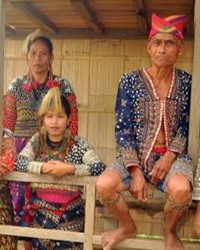The Kalagan name combines words for “fellow” and “to inform.” They were once the people who brought important news to neighboring tribes.
The Kalagan live on the island of Mindanao in the southern Philippines. They are located in an area between the interior uplands and the western coast of the Davao Gulf. The Kalagan are one of various groups of lowland Filipinos who came to the islands from Asia's southwestern mainland several thousand years ago. Their lifestyle and culture are very similar to that of the Maguindanao.
With the arrival of Islam in the 1500s, the Kalagan split into two separate groups-the Tagakaulu Kalagan and the Tagakaolo Kalagan. The Tagakaulu Kalagan speak Tagakaolo, which is closely related to a number of other languages spoken in the region.
While some of the Tagakaulu Kalagan receive wages for labor, others work as farmers. Maize is the major crop grown and is harvested two or three times a year. The coastal Kalagan are also fishermen; others work as laborers on plantations.
The Tagakaulu Kalagan are self-sufficient farmers, producing nearly all of their own food. Wet-rice is grown in the lowlands, and dry-rice and corn are farmed in the upland areas. Yams and sweet potatoes are also staple crops. They grow vegetables such as tomatoes, squash and beans. They also have many tropical fruits, especially coconuts. They raise goats for meat, and chickens for both eggs and meat. In addition to farming, the Tagakaulu Kalagan catch fish and obtain wild foods and other various materials from the marshes around them.
Those of the highest rank in their society do not perform manual labor. Among the rest of the population, male/female division of labor is not very pronounced. Generally, men do the plowing, tilling, and other heavy farm work. The women do most of the domestic work, often assisted by their older children.
Tagakaulu Kalagan art is confined mostly to weaving, basket making and producing certain ornaments. Personal adornment in the form of bright clothing, beaded jewelry and other accessories is distinctive and colorful. On special occasions, graceful dances are performed to the rhythmic music of gongs and other instruments.
The Tagakaulu Kalagan social structure is unusual because it is modified by a system of social rank, certain rules of descent, and distinctive marriage patterns. For most purposes, social rank is less important than blood ties. Higher-ranking families maintain elaborate genealogies to prove their claims of descent.
They prefer to marry into related families, especially second cousins. After marriage, the couple usually resides in the husband's community. Today, however, many young couples form their own independent households.
The Tagakaulu Kalagan were not introduced to Islam until Muslim missionaries arrived in the area during the 1500s. About half of the entire group of Kalagan came under Islamic influence at that time, and the group divided. Most of the Tagakaolo Kalagan became Muslims; however, the majority of the Tagakaulu Kalagan remained animists (believe that non-human objects have spirits). Today, many are still ethnic religionists, believing in the traditions and religions of their forefathers. They continue to believe in a variety of environmental spirits. Others have put their faith in Christ; these can bring in a full harvest.
Although mission agencies have worked among the Tagakaulu Kalagan, their response to the gospel is incomplete. They need to disciple those who are faithful to the spirit world rather than putting all their faith in Jesus Christ.
Ask the Holy Spirit to grant wisdom and favor to anyone helping the Kalagan people find their way to the cross and the empty grave.
Pray that God will give Tagakaulu Kalagan believers boldness to share Christ with anyone in their families and villages.
Pray for spiritual hunger and a willingness to stand for Jesus no matter what the cost.
Scripture Prayers for the Kalagan, Tagakaulu in Philippines.
https://en.wikipedia.org/wiki/Kalagan_people
| Profile Source: Joshua Project |











